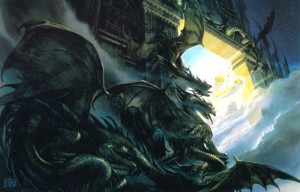
Hence only a powerful Elf lord like Ecthelion or a Wizard like Gandalf could dispatch a Balrog[36]; and the Black Riders pursuing Frodo feared Glorfindel[37], because “those who have dwelt in the Blessed Realm live at once in both worlds, and against both the Seen and the Unseen they have great power.”[38]
Magic, which according to Tolkien was employed by both Elves and Wizards, albeit “sparingly”, is “an inherent power not possessed or obtainable by Men as such.”[39] Thus when Gandalf told the Fellowship at the Bridge of Khazad-dûm that the Balrog “is a foe beyond any of you”[40], he did not mean (mainly) that it surpassed Aragorn and Boromir in physical strength but that, as he had told Aragorn earlier at the Chamber of Mazarbul: “swords are no more use here”[41] — although they might have been against a non-magical dragon.
Finally, it may have been that Tolkien’s penchant for human dragon-slayers simply reflected his study of Beowulf[42] and the Völsunga saga, in both of which the human hero (Beowulf; Sigurd) killed a dragon (an unnamed one; Fafnir). But since Tolkien was quite willing to alter themes from mythology and folkore to fit into his legendarium, it’s hard to believe that he would have hesitated doing so with dragon-slaying, if such had suited his purposes.
That fact that he did not, that only Men killed the dragons of Middle-earth — just as in the early medieval epics of northern Europe — would seem to indicate that Tolkien believed these terrible creatures to be the appropriate antagonists for the heroes of Men, even in a world populated with Elves, Dwarves and other Free Folk. As such, it is little exaggeration to say that these four dragon-slayers helped save Middle-earth: Ancalagon and Glaurung might have snatched for Morgoth victory from the jaws of defeat; Scatha and certainly Smaug could have done the same for Sauron, or at least insured that, even were the One Ring destroyed, the victors in Gondor and Rohan would have found in the North “only ruin and ash”[43] afterwards.
Indeed, it was Eärendil, Turin, Fram and Bard who, in no small measure, made possible the post-Elven “Dominion of Men” by eliminating four of Middle-earth’s most dangerous (and sentient) WMDs.
Footnotes:
[33] “Of the Voyage of Eärendil”, p. 252.
[34] The Children of Hurin, p. 180.
[35] The Hobbit, p. 223.
[36] Despite Gandalf’s using the sword Glamdring against the Balrog in Moria, it seems clear that the Grey Wizard’s main weapons against this evil spirit were, rather, the otherworldly, myterious “Secret Fire” and “flame of Anor” (LOTR, p. 330).
[37] LOTR, p. 214.
[38] Ibid., pp. 222-223, when Gandalf is explaining to Frodo what happened at the Ford of Bruinen.
[39] Letters, p. 200.
[40] LOTR, p. 330.
[41] LOTR, p. 326.
[42] http://en.wikipedia.org/wiki/Beowulf
[43] “Appendix A”, “Annals of the Kings and Rulers”, III, “Durin’s Folk”, LOTR, p. 1080. And possibly “no Queen in Gondor”, if Rivendell had been ravaged by Smaug — to the great loss of not just Aragorn and Gondor, but all Men going forward.
Timothy R. Furnish holds a PhD in Islamic, World and African history. By day he consults to the US government and military on issues relevant to those fields; at night and weekends he researches and writes about other ones, particularly Tolkien. He is writing a book, due out from Oloris Publishing next year, entitled Glorious Warriors and That Which They Defend: A Military and Political History of Middle-earth.


